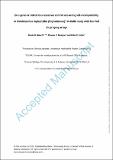Do s genes or deleterious recessives control late-acting self-incompatibility in Handroanthus heptaphyllus (Bignoniaceae)? A diallel study with four full sib progeny arrays
Abstract
Background and Aims Genetically controlled self-incompatibility (SI) mechanisms constrain selfing and thus have contributed to the evolutionary diversity of flowering plants. In homomorphic gametophytic SI (GSI) and homomorphic sporophytic SI (SSI), genetic control is usually by a single multi-allelic locus S. Both GSI and SSI prevent self pollen tubes reaching the ovary and so are pre-zygotic in action. In contrast, in taxa with late-acting self-incompatibility (LSI), rejection is often post-zygotic, since self-pollen tubes grow to the ovary where fertilization may occur prior to floral abscission. Alternatively, lack of self fruit set could be due to early-acting inbreeding depression (EID). The aim of our study was to investigate mechanisms underlying lack of selfed fruit set in Handroanthus heptaphyllus in order to assess the likelihood of LSI versus EID. Methods We employed four full sib diallels to study the genetic control of LSI in Handroanthus heptaphyllus using a precociously flowering variant. We also used fluorescence microscopy to study the incidence of ovule penetration by pollen tubes in pistils that abscised following pollination or initiated fruits. Key Results All diallels showed reciprocally cross-incompatible full-sibs (RCI), reciprocally cross compatible full-sibs (RCC), and non-reciprocally compatible full-sibs (NRC) in almost equal proportions. There was no significant difference between the incidence of ovule penetrations in abscised pistils following self- and cross-incompatible pollinations, but those in successful cross pollinations were around twofold greater. Conclusions A genetic model postulating a single S locus with four s alleles, one of which, in the maternal parent, is dominant to the other three, will produce RCI, RCC and NRC situations each at 33 %, consistent with our diallel results. We favour this simple genetic control over an early-acting inbreeding depression (EID) explanation since none of our pollinations, successful or unsuccessful, resulted in partial embryo development, as would be expected under a whole genome EID effect.
Citation
Bianchi , M B , Meagher , T R & Gibbs , P E 2021 , ' Do s genes or deleterious recessives control late-acting self-incompatibility in Handroanthus heptaphyllus (Bignoniaceae)? A diallel study with four full sib progeny arrays ' , Annals of Botany , vol. 127 , no. 6 , mcab031 , pp. 723–736 . https://doi.org/10.1093/aob/mcab031
Publication
Annals of Botany
Status
Peer reviewed
ISSN
0305-7364Type
Journal article
Description
MBB thanks the Consejo de Investigaciones de la Universidad Nacional de Rosario (CIUNR) for financial support.Collections
Items in the St Andrews Research Repository are protected by copyright, with all rights reserved, unless otherwise indicated.

